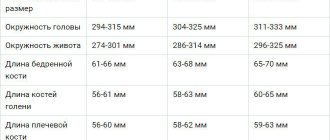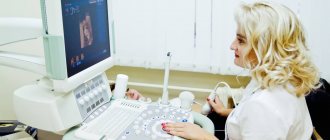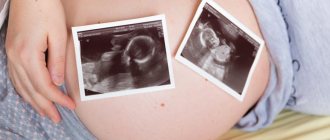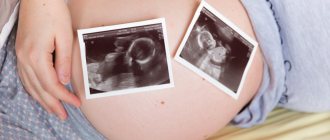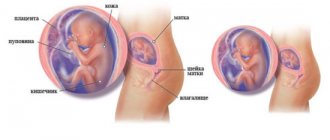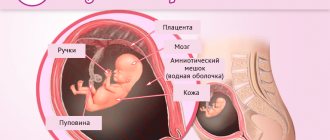Interesting Facts
| Options | Indications |
| Time from conception | 15 weeks |
| Period by month | 17 weeks |
| What month | 4 |
| Dimensions and weight of the fetus | 150 mm, 100-120 g |
| Uterus dimensions | 3-4 cm below the navel |
| Pregnant weight | Over the last week the increase is no more than 400-500 g |
Your baby is the size of
pear
150mm Size
100-120 g Weight
The 17th obstetric week of pregnancy is the period when the weight and height of the unborn child begins to actively increase. Because of this, mom experiences new sensations.
Are there any differences in the shape of the abdomen during pregnancy with a boy and a girl?
To determine whether there will be a son or a daughter, many mothers recommend paying attention to the shape of the abdomen. The result of long-term observations of pregnant women was the following conclusions:
- If there is a girl in the stomach, then its shape will resemble a melon. The longer the weeks, the more blurry the belly becomes. Due to its melon-shaped shape and constant growth, the stomach gradually begins to lose its clear outline. All this makes the waist unnoticeable;
- If there is a boy in the tummy, then its shape will be pointed and raised towards the top. The more weeks, the more noticeable the growth of the abdomen along with the protruding and upturned navel will be.
Young mothers diagnosing the gender of their unborn baby based on characteristics such as height and abdominal shape should remember that there is an error. This method works effectively only in certain cases: if a woman is pregnant for the first time, her figure has ideal parameters, and there are no deviations from the norm in the size of the fetus.
In other cases, guessing whether a baby will be a boy or a girl based on height and belly shape may be wrong. The reason for this may be individual physiological characteristics. Information about the shape of the abdomen in women along the family line when carrying a boy or a girl will help to increase the accuracy of the result. However, even in this case, it is not worth starting preparations for the birth of a baby of the assigned gender. The shape and growth of the abdomen can be influenced by various factors:
- During a multiple pregnancy, the belly differs significantly in size due to the growth of several babies;
- The fact that a woman is not primiparous will significantly complicate the determination of the sex of the fetus based on such abdominal parameters as shape and height. During the first pregnancy, the shape of the abdomen is pointed, and during subsequent births it may change due to stretching of the abdomen;
- If there is excess amniotic fluid, the belly will look larger than it should be at a given number of weeks;
- Underneath the mother's plumpness, the growth of the abdomen may be hidden;
- If the child has taken a non-standard position in the womb (obliquely or transversely), then the shape of the abdomen will be changed;
- In women with a narrow pelvis, regardless of the sex of the fetus, the abdomen will be sharp and neat in shape, as well as small in size;
- If there is an increase in the size, weight and height of the fetus relative to the norm, then the belly will be larger.
In addition, the shape of the abdomen can change under the influence of muscle tone inherent in the uterus and abdominal wall. For large and tall women, it is more difficult to determine the gender of the child based on abdominal parameters alone, since its growth is not noticeable for a long time. Expectant mothers with a fragile build and short stature will have a larger belly from the very early weeks.
Many women in labor claim that during the period of bearing a child of one sex, some signs characteristic of pregnancy with a child of the other sex arose.
Feelings of the expectant mother
At the 17th week of pregnancy, the actively growing uterus is palpated four centimeters below the navel. Now it is growing upward, pressing and slightly displacing the internal organs. In this regard, the expectant mother is faced with a frequent urge to urinate, heartburn and shortness of breath. The abdomen is noticeably rounded.
In a lying position, a woman may first notice the baby's movements. At first they look like an air bubble rolling inside. After a couple of weeks, the mother will get used to these sensations and will even be able to determine from them where the baby is at the moment, in what part of the abdomen. Movements will become an important method of communication between mother and baby, an indicator of his well-being, periods of sleep and wakefulness.
Some pregnant women note that at the 17th week of pregnancy, the décolleté area is covered with a bright mesh of veins. This is fine. Indicates that the mammary gland is preparing for lactation.
Increased blood circulation and high stress on small blood vessels can cause nosebleeds, and the sensitivity of the gums also increases to the point of bleeding.
What happens at 18 weeks of pregnancy
The uterus with the baby located inside it reaches the level of the navel at 18 weeks, which is why the woman experiences some discomfort. Her belly is becoming more and more visible, and it is almost impossible to hide it with clothes. Another 18 week is the time to purchase a special bandage for pregnant women, which allows you to hold your stomach and prevent stretch marks from appearing on the skin.
Typically, at this stage of pregnancy, the expectant mother adds an average of 6 kg to her usual weight. Her breasts become very sensitive, and discharge from the nipples may occur. Such discharge does not cause much concern. Their color is white, slightly yellowish. It is not recommended to massage the breasts, especially if there is a threat of miscarriage. Such manipulations can lead to increased uterine tone and, as a result, spontaneous termination of pregnancy.
Many women during this period of time do not neglect sexual intimate relationships with a partner, but sex at 18 weeks of pregnancy becomes very monotonous. A growing belly makes a woman clumsy, and she may experience discomfort in certain positions. Deep penetration should be avoided.
What's happening to the baby
At the 17th week of pregnancy, the fetus is growing rapidly and gaining weight due to the formation of subcutaneous fat. It will help the baby regulate body temperature after birth: newborns, contrary to popular belief, rarely freeze thanks to warming brown fat.
The baby becomes noticeably more well-fed. His weight at week 17 is 100-120 grams, his height is on average 15 cm. He moves a lot, there is now enough space in the uterus for this. Actions are now more coordinated.
If previously the child’s chin was pressed to the chest, now the neck straightens and the head gradually takes a vertical position. The baby actively trains grasping, swallowing and breathing reflexes.
Other development successes:
- At week 17, the formation of the cardiovascular system, nodes, bundles and fibers of the heart, necessary for healthy cardiac activity, is completed.
- Alveoli form in the bronchi.
- Sweat glands are located in the skin.
- The baby learns to recognize sounds: some calm him, like his mother’s voice, while others, sharp ones, can cause fear.
- In girls, the uterus is already forming, in boys - the prostate.
Nutrition

Nutrition for a pregnant woman at 18 weeks
The diet of a woman in the 18th week of pregnancy should provide the expectant mother and her baby with all the necessary nutrients. An increased appetite is not a reason to forget about simple rules:
- portioned meals. You need to eat 5-6 times a day, in small portions;
- Do not mix different dishes into one meal;
- you need to follow the drinking regime. Drink 2 - 2.5 liters of liquid per day. It is better to give preference to drinking water;
- It is advisable to make the diet from vegetables and fruits, not forgetting to include meat and dried fruits;
- It is recommended to cook by steaming or in the oven. Fried foods are best avoided. Avoid smoked, dried and salted foods.
At the 18th week of pregnancy, the fetus consumes many vitamins and minerals from the mother's body. To provide him with everything he needs and maintain his own health, it is advisable for the expectant mother to consume products containing:
- Calcium: cottage cheese, cheese, almonds, white beans, bananas, broccoli, sesame;
- Magnesium: buckwheat, oatmeal, brown rice, chicken eggs, spinach, walnuts;
- Vitamin D: beef liver, chicken eggs, sea fish, red caviar;
- Iodine: prunes, cod, turkey, potatoes, seaweed, strawberries, cranberries;
- Zinc: carrots, beets, cabbage, bran, beef liver, chicken;
- Iron: beans, apples, offal;
- Selenium: buckwheat, oatmeal, meat, offal, seaweed;
- Fluoride: chicken eggs, buckwheat, rice, apples, chicken and beef;
- Phosphorus: fish, chicken eggs, dairy products;
- vitamin A: carrots, pumpkin, liver, dried apricots;
- B vitamins: red meat, walnuts, bananas, oats, asparagus, almonds;
- Vitamin C: rosehip, red bell pepper, sea buckthorn, black currant, parsley, kiwi, citrus fruits;
- Vitamin E: fish, spinach, chicken eggs, almonds, broccoli, sunflower seeds;
- Vitamin K: asparagus, cucumbers, green onions, prunes, broccoli.
Vitamins
In addition to a proper diet, your gynecologist may recommend taking vitamins or supplements. Multivitamin complexes should be taken strictly in the prescribed dosage. A pregnant woman should remember that an excess of vitamins can be as harmful as their deficiency.
Weight
During the 18 weeks of pregnancy, most women gain between 3 and 5 kg in weight. For the next 7 days, it is advisable to gain no more than 400 g.
If, without changing the diet, while observing the rules of eating behavior, a woman has gained more than a kilogram in a week, this is a reason to consult a doctor. Very often, excess weight hides edema, which he must be aware of.
Tests and ultrasound
At 17 weeks, it is optimal to undergo a second pregnancy screening. It includes an ultrasound examination and a blood test for 3 hormones, the so-called triple test. It is often prescribed according to indications if the results of the first screening and second ultrasound are in doubt.
What parameters are recorded during an ultrasound?
- head and abdominal circumference;
- length of femur and humerus;
- estimated fetal weight;
- approximate volume of amniotic fluid;
- position of the placenta (attachment to the anterior or posterior wall);
- attachment of the umbilical cord, the number of vessels and blood flow in them;
- fetal heartbeat;
- cervical length.
These data help to assess the rate of fetal development in accordance with the timing of pregnancy, identify genetic pathologies, and the risks of threatened miscarriage.
Necessary examinations at the eighteenth week
At the 18th week of pregnancy, it is necessary to visit a gynecologist for the fourth time from registration and undergo an examination. Don’t forget your personal card at home, which contains important indicators, results of tests performed during pregnancy, etc. Then you should visit a therapist, be weighed and have your blood pressure measured.
At this stage of pregnancy, many women experience kidney and bladder diseases. Also, pregnancy is the most opportune moment for the exacerbation of many chronic pathologies. Therefore, it would not be superfluous to have a urine test to identify inflammatory processes in these organs.
In addition, it is necessary to undergo a clinical blood test, which allows you to determine the condition of the body as a whole and diagnose diseases that can harm the development of the child. Women who have not yet undergone second trimester screening need to do so now. Experts advise doing a “triple test” even earlier, at 16 or 17 weeks of pregnancy. The test involves examining the patient’s venous blood for the content of hCG and certain hormones and proteins secreted by the fetus.
Additional tests are ordered by a specialist if there are suspicions of any abnormalities in the development of the fetus.
Warning symptoms you shouldn't worry about
I don’t feel any movement – is this normal?
Yes, quite, during the first pregnancy you can feel normal fetal movements at 16-22 weeks.
I have tightness in my lower back and lower abdomen – is this a miscarriage?
Pain in the lower back at week 17 is most often associated with an increasing load on the back and a shift in the center of gravity due to an expanding abdomen. Massage and rest will help you; on the recommendation of your doctor, you can wear a support bandage. Pain in the abdomen may be associated with a growing uterus and stretching of the ligaments that hold it in place. But if the pain is unbearable and is accompanied by bloody discharge, then you should immediately seek medical help.
A runny nose does not go away - what to do?
The mechanism of the occurrence of a runny nose during pregnancy is not fully understood. It is believed that nasal congestion without signs of inflammation or allergies occurs in pregnant women due to hormonal changes. Pregnancy hormones relax the smooth muscles of the walls of the blood vessels in the nasal mucosa, resulting in nasal congestion.
In this case, rinsing the nose with water-salt solutions and maintaining air humidity in the room at 40-60% can help. The use of vasoconstrictor drugs is not recommended: they are addictive.
Body temperature 37-37.2°C – is this inflammation and a cold?
A slight increase in temperature during pregnancy is caused by a high concentration of progesterone in the blood. This is normal and does not affect the woman’s well-being in any way.
Determining the sex of a child by ultrasound during pregnancy
Pregnancy is the most wonderful time in a woman’s life. This is the time for surprises. Every movement of the baby and an extra centimeter on the tummy is expected with great interest. Naturally, the expectant mother is always tormented by the question of the gender of her child. There are many folk methods, fortune telling and Chinese gender determination tables. Determining the sex of a child using ultrasound is the most accurate method in medicine.
Determining the sex of a child by ultrasound
Ultrasounds during pregnancy are performed three times: one in the first trimester, one in the second and one in the third. At each visit to the ultrasound room, the state of fetal development is assessed.
By 21-22 weeks of pregnancy, all the baby’s genitals are already formed and more expressive. The doctor can tell mothers with greater accuracy what color baby clothes they should buy: pink or blue.
The girl's labia are visible on the monitor, while the boy's scrotum and sometimes the penis itself.
A great achievement in medicine is the invention of the 3D ultrasound sensor. This method of fetal examination is now the most popular. It allows you to identify not only the organs and bones of the baby, but also see his face, make out his smile, nose and eyes.
3d ultrasound is performed from the 24th week of pregnancy. All parents look forward to this moment of meeting their child. All clinics performing this procedure can also take a photo of the doll.
The first photograph of an unborn child is a very important moment in the life of future parents.
The advantage of the three-dimensional study is that there is a unique opportunity to find out all the malformations before birth and change pregnancy management tactics in time.
For example, facial defects are not visible with conventional ultrasound. Another plus is that this method allows you to find out the sex of the baby more accurately.
This is very important in the presence of hereditary pathologies
In this case, it is prescribed at 14-17 weeks of pregnancy.
The most common question that concerns all parents is how harmful is the effect of ultrasound on the baby during diagnostics? Clinical studies have proven that three-dimensional observation in the amount prescribed by the doctor is safe for the baby and mother. However, you should not do an ultrasound without permission without a doctor’s recommendation.
When will the test reveal the gender of the baby?
The baby's genital organs begin to form as early as 8 weeks, and at 12 weeks, an experienced doctor can see them on an ultrasound. But not all equipment will allow you to do this.
Therefore, pregnant women are looking forward to the middle of the second trimester, when the belly is already sticking out with might and main and the baby is felt more and more clearly. The most accurate determination of the baby's gender is possible only from 21 weeks.
Although many impatient expectant mothers come for an ultrasound at 20 weeks, it happens that the doctor tells them the good news. But even here the child can present a surprise - hide his private part by crossing his legs.
Ultrasound image of a boy and a girl
Gender of the child: is ultrasound wrong?
To the question “Does ultrasound make mistakes?” the answer will be: “The doctor performing the procedure is mistaken.”
In fact, many babies do not like being watched and when a sensor is brought to their stomach, they immediately begin tossing and turning.
Mistaking a finger for a male genital organ is quite possible, especially if the child is constantly moving. When determining sex at an earlier stage, when the baby is still very small, it is quite possible to make a mistake.
We cannot exclude the factor that the equipment in all clinics is different. Some have a newer one, others have an older one. Therefore, if you come to different clinics, you can get, accordingly, different results. The blurriness of the image may well lead the doctor to an inaccurate result.
Ultrasound 24 weeks - girl
Is it possible to find out the sex of a child without an ultrasound?
The mother begins to feel the first movements of the baby already at 19 weeks. At this moment, she begins to experience joy and is already fully aware of her future role of motherhood and looks forward to the answer to the question “who is there inside?” Therefore, many mothers, trying to satisfy their curiosity, resort to different methods without waiting for an ultrasound.
You can do a blood test for hormones. If there are more males, then there will be a son and, on the contrary, females, then a daughter. There are many traditional methods to find out the sex of a child. Parents believe in various omens, look at Chinese tables, and go to psychics.
There is also a method to find out who is in the tummy by updating the blood of the parents. Whoever has the last parent, she was renewed, the baby is of the same gender. In men, blood renewal occurs every 4 years, and in women every 3 years. And with large blood loss or operations, blood renewal also occurs.
All methods give a result of 50x50.
Lifestyle: our recommendations
In the second trimester, when you have a lot of strength and energy, exercise for 30 minutes for 3-5 days a week. You don't have to go to the gym. You can do simple exercises at home. For this, we recommend that you purchase a fitball, which will be useful in the future for activities and games with your baby and during motion sickness.
Physical education during pregnancy will prevent excessive weight gain, improve sleep and psycho-emotional state, and prepare the body for childbirth.
Dietary recommendations
Throughout pregnancy, your diet should be balanced and nutritious. What does it mean? Your daily menu should include:
- 4-5 servings of fruits and vegetables;
- 4 servings of dairy or other calcium-rich products;
- 3 or more dishes made from whole grains (porridge, whole grain bread, durum wheat pasta);
- 2-3 – lean protein, that is, meat and a variety of legumes.
You should have fish on your table 2 times a week, but don’t often choose fish that can accumulate mercury, for example, tuna, marlin, swordfish.
Do you need vitamin supplements?
If you eat a varied diet, are not a vegetarian, and have access to vegetables and fruits all year round, then you do not need additional vitamin intake. The exception is folic acid in the early stages of pregnancy and vitamin D, the deficiency of which in our region is associated with the number of sunny days per year.
If you have any chronic diseases, for example, the thyroid gland, you may need additional iodine. The issue of taking medications should be decided together with the doctor monitoring the pregnancy.
Checklist for 17 weeks of pregnancy
- Drink enough water and choose foods high in fiber. This is the best prevention of constipation during pregnancy.
- Choose comfortable maternity clothes. Nothing should restrict your movements or put pressure on your stomach.
- Remember to do pelvic floor exercises to prevent postpartum complications such as genital prolapse and urinary incontinence.
The seventeenth week of pregnancy is the optimal time for 2 screenings. Sign up for the procedure at any time convenient for you by contacting the Women's Medical Center. You will avoid queues and long waits, and receive the most accurate results within 1-2 days.
What is 3D ultrasound?

But as for the conduct of this survey, there are several aspects, both ethical and from a safety point of view. It’s worth starting with ethical ones, since representatives of some religions and social movements are against conducting three-dimensional ultrasound examinations without medical indications. However, the vast majority have nothing against performing this diagnostic measure if indicated.
This is especially true for the most modern devices with a minimized frequency of ultrasonic waves. As a result of this mixed response on whether 3D ultrasound is harmful to the fetus, doctors were divided into two groups. Some believe that there is no harm from 3D ultrasound and it can be performed even if parents wish, while others prescribe it exclusively for medical reasons.
Psychologists also say that 3D ultrasound is useful for expectant parents. It allows you to “get to know” the baby earlier, which will have a positive impact on the relationship between parents and child in the future.
After the examination, you can get ultrasound pictures of a boy or girl and these will be their very first photos. But with 4D ultrasound you can even get the first video recording. However, conventional ultrasound machines also have a similar function, but not all.
Is it possible to find out the gender of the baby at 12 weeks?

The sex of the child is determined and remains unchanged from the moment of conception. At week 9, the formation of the fetal genital organs begins. The formation of ovaries (in girls) and testicles (in boys) occurs. By week 12, differentiation and formation of the genital organs occurs. They can already be seen during an ultrasound. A woman is interested in finding out the sex of her unborn child, but visually the genitals of boys and girls may look the same at this stage. This is explained by the fact that some girls experience swelling of the labia. Therefore, even with sufficient visualization of the groin area of the fetus, errors in determining sex are possible with ultrasound. Take your time!
If it is necessary to determine the sex of the fetus at such a short time, it is better to use laboratory methods, although they will not give a 100% guaranteed result.
Is it possible to feel fetal movements at this stage?
Every woman asks questions about what her baby will be like, who he will look like, what gender and eye color. The expectant mother is looking forward to the manifestations of the child’s motor activity. She listens carefully to every new sensation in her stomach. However, what may be perceived as fetal movement is peristaltic waves of the intestines. The baby is still so small that he fits freely in 50 ml of amniotic fluid. His chaotic movements do not bother his mother. She will be able to feel them from 14-15 weeks.
Baby development
The baby's intrauterine development continues. Organs and systems have already been laid down earlier. By the end of the first trimester, the structure becomes more complex and functional activity increases:
- heart rate
reaches 110-160 per minute. Now it can already be determined using a special study (Doppler) and ultrasound. - The maturation of the thymus begins the formation of the fetal immune system.
The formation of the first leukocytes - white blood cells - occurs. - The pituitary gland synthesizes hormones.
They are included in the regulation of the functioning of internal organs. - The development of the gastrointestinal tract continues.
The secretion of bile by the liver initiates intestinal contractions. At this stage, the baby can digest glucose. The intestinal mucosa becomes covered with folds, which will later take part in digestion. The entire abdominal cavity is filled with intestines. - The skeleton
consists of cartilage tissue. Bone substance begins to form in it. Ossification points require increased calcium intake into the body. - Marigolds appear on tiny fingers
- The genital organs
have reached a size that is already visible during an ultrasound. - motor activity
increases. This is not only flexion and extension of limbs and fingers, nodding movements. The baby sucks his thumb, opens and closes his mouth, and swallows amniotic fluid. - The amniotic fluid
is completely replaced every day. - The kidneys
produce urine. - From the level of the cervical region, the ears
rise to the head. - is formed .
At this stage of development, the baby feels vibration. The sensitivity of all receptors increases.
Nervous system
continues to develop. The interaction between the brain and spinal cord is being established. Preparations are underway for the transfer of regulatory function to the brain. Until this moment, movements will be chaotic.
Fruit size
At 12 weeks of pregnancy, the baby reaches 6-9 cm. It corresponds to the size of a medium-sized lemon. The weight of the fetus during this period can reach 13-15 grams. The question may arise, why does it weigh so little? After all, the mass of a lemon is more than 100 grams? Everything is very simple. The baby has reached the size of a lemon in length, not in volume. If the fruit is filled with liquid, like a ball, then the growing organism is more correctly compared to a pea pod, because it is still so thin.
Is it possible to calculate the sex of a baby before conception with high reliability?
During the entire pregnancy, a woman must undergo three mandatory ultrasounds.
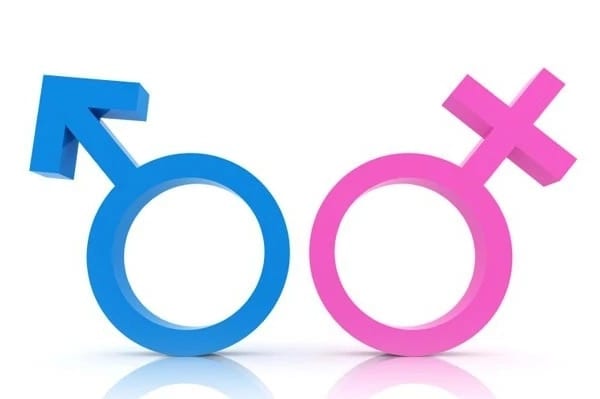
The first is before the 12th week to confirm the fact of pregnancy and exclude possible pathologies that arise in the early stages (ectopic or frozen pregnancy). Then, at 20-22 weeks, the doctor looks at how the baby is developing in the womb and determines whether there are any pathologies that can be seen from the data obtained during the study. And already in the third trimester, the condition of the placenta (the degree of its maturity), the amount of amniotic fluid, and the baby’s weight are diagnosed.
There are tables by which you can supposedly determine the sex of a child, knowing the age of the father, mother, month of conception and some other parameters. Let's look at them.
Japanese table
There is also another table. It can be seen below.
Some experts believe that the gender of a child can be determined in advance by the blood type of the parents. This can be done using the following table.
| Blood type | Father | ||||
| 1 | 2 | 3 | 4 | ||
| Mother | 1 | d | m | d | m |
| 2 | m | d | m | d | |
| 3 | d | m | m | m | |
| 4 | m | d | m | m |

Here the letter d is a girl, and the letter m is a boy.
You can also find out the baby’s gender by the Rh factor of the father and mother. To do this you need to use the following table.
| Rh factor | Father | |
| – | ||
| Mother | d | m |
| – | m | d |
Such methods for calculating the sex of a baby are considered very simple, which is their advantage. We must not forget that, from a scientific point of view, it is impossible to accurately calculate whether a boy or a girl is in a mother’s tummy using any tables.
Budyansky method
So how to use this method? It is believed that a woman can conceive a girl or boy only during even or odd menstrual cycles. The month in which the girl herself was conceived and will be considered female for her. That is, the next month after her conception will be considered favorable for conceiving a boy. In the table you can calculate the sex of the baby based on the last menstruation.
| Menstrual months | Year of conception (even) | Year of conception (odd) |
| Types | ||
| 1-28 Jan. | n | h |
| Jan 29-Feb 25 | h | n |
| February 26-March 25 | n | h |
| March 26-April 22 | h | n |
| April 23-May 20. | n | h |
| May 21-June 17 | h | n |
| June 18-July 15 | n | h |
| July 16-Aug 12 | h | n |
| 13 Aug.-9 Sept. | n | h |
| 10 Sept.-7 Oct. | h | n |
| 8 Oct.-4 Nov. | n | h |
| November 5-December 2 | h | n |
| 3 Dec.-31 Dec. | h | h |
The calendar consists of two years, which are divided into even and odd. Here, odd cycles are denoted by the letter - H, and even cycles, respectively, by the letter - H. Calculating the female and male months for mommy using menstruation is not difficult.
A one hundred percent guarantee of determining the sex of a baby during pregnancy planning is a myth. Compliance with the rules of none of the proposed methods can fully guarantee the conception of a boy or girl. In addition, it is impossible to accurately determine the sex of the baby based on any signs, age, blood type, lunar calendar, Rh factor and other characteristics at home.
Until the 20th obstetric week of pregnancy, no specialist can guarantee who is in the tummy, even with the latest equipment at hand. Often the child turns away during the examination and hides, which does not allow his gender to be accurately seen.
